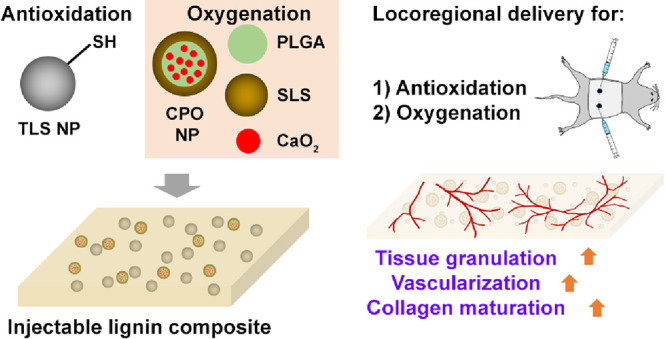- Record: found
- Abstract: found
- Article: found
Injectable Antioxidant and Oxygen-Releasing Lignin Composites to Promote Wound Healing

Read this article at
Abstract

The application of engineered biomaterials for wound healing has been pursued since the beginning of tissue engineering. Here, we attempt to apply functionalized lignin to confer antioxidation to the extracellular microenvironments of wounds and to deliver oxygen from the dissociation of calcium peroxide for enhanced vascularization and healing responses without eliciting inflammatory responses. Elemental analysis showed 17 times higher quantity of calcium in the oxygen-releasing nanoparticles. Lignin composites including the oxygen-generating nanoparticles released around 700 ppm oxygen per day at least for 7 days. By modulating the concentration of the methacrylated gelatin, we were able to maintain the injectability of lignin composite precursors and the stiffness of lignin composites suitable for wound healing after photo-cross-linking. In situ formation of lignin composites with the oxygen-releasing nanoparticles enhanced the rate of tissue granulation, the formation of blood vessels, and the infiltration of α-smooth muscle actin + fibroblasts into the wounds over 7 days. At 28 days after surgery, the lignin composite with oxygen-generating nanoparticles remodeled the collagen architecture, resembling the basket-weave pattern of unwounded collagen with minimal scar formation. Thus, our study shows the potential of functionalized lignin for wound-healing applications requiring balanced antioxidation and controlled release of oxygen for enhanced tissue granulation, vascularization, and maturation of collagen.
Related collections
Most cited references65
- Record: found
- Abstract: found
- Article: not found
Reactive oxygen species (ROS) and wound healing: the functional role of ROS and emerging ROS-modulating technologies for augmentation of the healing process.
- Record: found
- Abstract: found
- Article: not found
Extracellular Matrix Reorganization During Wound Healing and Its Impact on Abnormal Scarring.

- Record: found
- Abstract: found
- Article: found